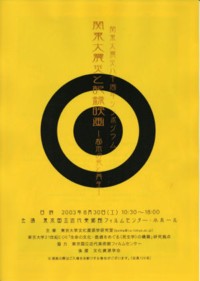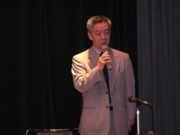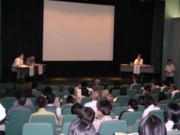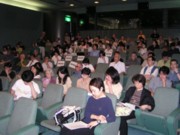
 |
|
Symposium :
|
|
August 30, 2003 10:30-18:00 at Small hall, National Film Center, The National Museum of Modern Art, Tokyo
|
 |
Screening of documentary films of the Great Kanto Earthquake. (10:30-12:00)
Screening of documentary films reporting the Festival for the Rehabilitated Imperial Capital. (15:30-16:30)
On August 30th, 2003, at National Film Center, The National Museum of Modern Art, Tokyo, "The Great Kanto Earthquake and Documentary Films -The death and life of a city" Symposium was held to mark the eightieth anniversary of the Great Kanto Earthquake.
The sudden damage and large numbers of dead that accompany a great natural disaster force the survivors to consider how to deal with memorializing the dead and then begin steps toward recovery. Therefore, these disasters provide an extremely appropriate topic for Death and Life Studies. In particular, the Great Kanto Earthquake, which occurred on September 1st, 1923, and the subsequent series of projects to rebuild the Imperial Capital in the seven years that followed, can be taken as a valuable model for the process by which a large city goes through the process of death and rebirth.
The Great Kanto Earthquake and the projects to rebuild the Imperial Capital were recorded during the early days of cinematography. A small portion of these films still exist today. These were screened during the symposium in the hopes that they would provide avenues for further discussion. The National Film Center serves as an institution of research and analysis and has undertaken the preservation, release, discovery, and restoration of domestic films. All of the films screened at the symposium belong to the National Film Center.
Due to advanced notice in the Tokyo papers, the symposium was a great success. There were a number of elderly attendees who had heard stories of the earthquake from their parents and who wanted to see actual film of the event. The one-hundred and fifty seat hall was almost entirely full.
The first session included the screening of three films followed by a presentation on each. The films were: "A Commentary on the Great Earthquake and Conflagration of Kanto," "The Great Kanto Earthquake (Ina Seiichi Edition)," and "Treading through the Tokyo of Raging Flames and Corpses." In "Earthquake and the Death of a City," Ryûichi Narita follows newspaper reports of the earthquake and then actually traces the process by which certain items were chosen to portray the event. In this way we are able to analyze the ways in which the media constructed the realities and the stories of the earthquake. Akira Tochigi 's "That Which is Brought Forth in the Cinematic Expression after the Great Kanto Earthquake," explains how a film of the earthquake is actually shot and produced. He then goes on to show how these films contain the prototypical techniques that will later develop into documentary films and news films. In "Natural Disasters and Visual Media," Kenji Sato uses examples of popular media other than film such as "Current-events Postcards" and "rumors" of rebellious Koreans to consider what people try to get from complicated and fragmentary information.
In the second session, after a screening of parts of "Revival of the Imperial Capital," two reports were offered. Takeshi Hara, in his presentation entitled, "The Festival for the Reconstruction of the Imperial Capital and the Rebirth of the City," while focusing on the appearance in the films of the Emperor and the Imperial Palace, compares the differences in how these are portrayed in those films about the earthquake and those films that deal with the restoration. Naoyuki Kinoshita 's presentation, "Whereabouts of the Dead," uses a variety of angles to analyze the way in which the dead were treated. His different viewpoints include information terminology, different types of Buddhist memorial services, the construction of memorials, and the route taken by the Emperor during his tour of the restoration festivities.
 |
 |
 |